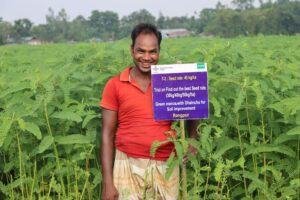The system of rice intensification (SRI) was developed in Madagascar 20 years ago by Fr. Henri de Laulanié of the Society of Jesus after 2 decades of working with farmers to raise their rice production without depending on external inputs. Today, SRI is gaining acceptance around the world. Practiced only in Madagascar until 1999, it has since demonstrated its environmentally friendly benefits from China to Cuba and from the Philippines to Peru.
SRI is still controversial in some circles, despite our ability — given more space than is available here — to explain in scientific terms why younger and fewer seedlings transplanted with wider spacing and no continuous flooding, and nourished by compost rather than chemical fertilizer, give much higher yield than conventionally grown rice.
By changing how plants, soil, water and nutrients are managed, SRI can achieve average yields about double the present world average of 3.8 t/ha. When the methods are applied well and so improve the soil, yields can reach 15-20 t/ha. SRI practices improve the growing environment of the plant so that any rice genotype can result in different, more productive phenotypes having much larger root systems. The growth and health of the plants are supported by the greater abundance and diversity of soil biota.
With SRI, farmers do not need new rice varieties, because all cultivars respond positively. The best SRI yields have been achieved with high-yielding varieties or hybrids, but even traditional varieties can produce 6-8 t/ha — and as much as 10-12 t/ha. Since SRI reduces seed requirements by 80-90%, it slashes otherwise significant hybrid seed costs. Farmers do not need to use chemical fertilizer or other agrochemicals, as the highest yields come with compost made from any available biomass, and SRI-grown plants naturally resist pests and diseases.
The possibility of achieving higher yields with a 25-50% reduction in water requirements addresses a growing need to conserve water in this century. As SRI rice paddies are not continuously flooded, they may also reduce greenhouse gas emissions, though this cannot be assessed until SRI is used on a larger scale. Stronger root systems help the plants stand up to drought, wind damage and cold spells, and also make more feasible ratoon crops harvested from stubble regrowth.
Farmers who adopt SRI need information and training but no new capital expenditures. Once initial skepticism is overcome, SRI is easy to learn and disseminate. Anyone who knows how to grow rice and is motivated can easily learn the system. As farmers are encouraged to experiment with variations to the methods and thus to improve them, developing human resources is an intrinsic part of SRI extension.
SRI requires more investment in water management to allow farmers to apply smaller amounts only as needed. And it is initially more labor-intensive by 25-50%. However, once farmers have mastered the methods, SRI can even become labor-saving and applicable on a large scale. One commercial farmer in the Godavari Delta of the Indian state of Andhra Pradesh planted nearly 45 ha to SRI rice in the last rabi (dry) season.
Some suggest that SRI is a niche innovation, relevant only for certain conditions regarding soil or other factors. However, practically all of the recent 300 kharif (wet) season on-farm trials of SRI in Andhra Pradesh, distributed across the diverse soils of its 22 districts, were successful (excepting those on saline soils). In China, SRI yield increases have been documented from Zhejiang in the east to Sichuan in the west, and from Hainan in the tropical south to Heilongjiang in the far north.
SRI is spreading because it is versatile and can more than double farmers’ net income. With respect to the agricultural and food-security needs of the new century, SRI is a “designer” innovation that efficiently uses scarce land, labor, capital and water resources, protects soil and groundwater from chemical pollution, and is more accessible to poor farmers than input dependent technologies that require capital and logistical support.
We hope that many institutions and individuals will join in helping to improve the understanding and spread of this innovation, which can go far toward meeting this century’s economic, social and environmental needs.
_________________________________________
Dr. Uphoff is director of the Cornell International Institute for Food, Agriculture and Development.









